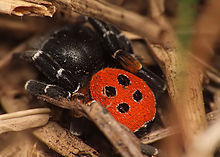- Eresus cinnaberinus
-
Eresus cinnaberinus 

Males Scientific classification Kingdom: Animalia Phylum: Arthropoda Class: Arachnida Order: Araneae Family: Eresidae Genus: Eresus Species: E. cinnaberinus Binomial name Eresus cinnaberinus
(Olivier, 1789)Synonyms Aranea nigra
Aranea cinnaberina
Aranea moniligera
Aranea quatuorguttata
Chersis dubius
Eresus 4-guttatus
Eresus guerinii
Eresus fulvus
Eresus kollari
Erythrophorus 4-guttatus
Erythrophorus cinnaberinus
Chersis niger
Eresus ruficapillus
Eresus niger
Eresus tristisEresus cinnaberinus (formerly Eresus niger), of the family Eresidae, is commonly called the Ladybird Spider. It is native to Europe.
The taxon "Eresus cinnaberinus" is considered a nomen dubium by some authors[citation needed], the specimens having been divided into the species E. kollari, E. sandaliatus and E. moravicus. The three species differ in size, colour pattern, shape of prosoma and copulatory organs, and habitat, with no morphologically intermediate forms. As eastern and western E. kollari are genetically different, with the eastern form likely a hybrid between "pure" E. kollari and E. moravicus, it is possible that later revisions will partition it into additional species.[1]
Contents
Description
Males are up to 11 mm long, females can reach up to 20 millimetres (0.79 in). Males have a black prosoma and a strikingly red opisthosoma with four black dots (sometimes with white lining), resembling a Ladybird. The black legs have white stripes, the hind legs are partly red. Females are black with some white hairs, only the front is sometimes yellow.
Distribution
It prefers sunny, dry locations and is widely distributed in Central and Southern Europe. In England, it can be found only in a "secret" half-acre patch of south-facing Dorset heathland.
Habits
These spiders live in up to 10 centimetres (3.9 in) long underground tubes with a diameter of about one centimetre. On top they are much wider and lined with cribellate silk. Many webs can usually be found in the same place, sometimes up to ten on a single square metre. E. cinnaberinus mainly catches millipedes and beetles. Males walk around during September, searching for females. If it finds one, it lives with the female in her tube, and they feed from the same web.[2]
Conservation
This spider is classified as endangered in Great Britain. It is given full protection under Schedule 5 of the Wildlife and Countryside Act 1981.[3] Reintroduction is in progress at the Arne RSPB reserve in Dorset, England.[4] In Germany it is also considered endangered.
History
Until the late 1920s the species was recorded from several sites in the English county of Dorset but was subsequently considered extinct in Britain. Rediscovered in 1979, it is known from only a single vulnerable, confirmed site in the town of Wareham. Other unconfirmed reportings have yet to be substantiated.
Subspecies
- Eresus cinnaberinus bifasciatus Ermolajev, 1937 (Russia)
- Eresus cinnaberinus frontalis Latreille, 1819 (Spain)
- Eresus cinnaberinus ignicomus Simon, 1914 (Corsica)
- Eresus cinnaberinus illustris C. L. Koch, 1837 (Hungary)
- Eresus cinnaberinus latefasciatus Simon, 1910 (Algeria)
- Eresus cinnaberinus tricolor Simon, 1873 (Corsica)
Footnotes
- ^ Rezac, Pekar & Johannesen 2008
- ^ Bellmann 1997
- ^ "Wildlife and Countryside Act 1981". Government of the United Kingdom. http://www.opsi.gov.uk/RevisedStatutes/Acts/ukpga/1981/cukpga_19810069_en_27#v00187-sch8. Retrieved 15 October 2010.
- ^ http://www.birdguides.com/webzine/article.asp?a=2835
References
- Population history of Eresus cinnaberinus (Araneae: Eresidae) colour variants at a putative species transition, abstract at PubMed
- Eresus cinnaberinus at the UK Biodiversity Action Plan website
- The Country Life Guide to Spiders of Britain and Northern Europe (Dick Jones) Published and copyrighted 1983 by Country Life (a division of Hamlyn Press) ISBN 0-600-35665-5
- Bellmann, H. (1997): Kosmos-Atlas Spinnentiere Europas. Kosmos.
- Řezáč, M.; Pekár, S. & Johannesen, J. (2008): Taxonomic review and phylogenetic analysis of central European Eresus species (Araneae: Eresidae). Zoologica Scripta 37: 263-287. doi:10.1111/j.1463-6409.2008.00328.x
External links

This spider–related article is a stub. You can help Wikipedia by expanding it.
